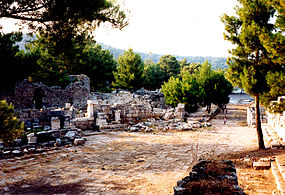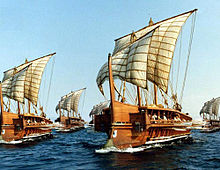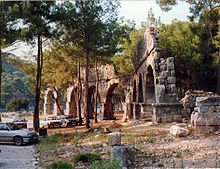|
Greek city of Phaselis in Lycia
Bronze 15mm (4.39 grams) Struck circa 300-200 B.C.
Reference: Sear 5341; B.M.C. 19.80,5,7; Heipp-Tamer B-20; SNG Copenhagen 12
Prow of galley right.
Stern of galley right, ΦΑΣH above.
The only Lycian city of purely Greek origin, Phaselis was
founded from Rhodos circa 690 B.C. Situated on the inhospitable coast, its fine
harbors ensured the development of the place as a great commercial center. The
abundance of its 3rd century silver coinage is evidence of the prosperity of
Phaselis in early Hellenistic times, a period of numismatic inactivity at the
native Lycian mints.
You are bidding on the exact
item pictured, provided with a Certificate of Authenticity and Lifetime
Guarantee of Authenticity.
Phaselis was an
ancient Greek
and
Roman
city on the coast of
Lycia
. Its ruins are located north of the
modern town Tekirova in the
Kemer
district of
Antalya Province
in
Turkey
. It lies between the Bey Mountains and
the forests of
Olympos National Park
, 16 km west of the
touristic town of Kemer
and on the 57th kilometre of the Antalya–Kumluca
highway. Phaselis and other ancient towns around the shore can also be accessed
from the sea by daily yacht tours.
History
The town was set up by the
Rhodians
in 700 BC. Because of its location on
an isthmus separating two harbours, it became the most important harbour city of
the western Lycia
and an important centre of commerce
between Greece
,
Asia
,
Egypt
, and
Phoenicia
, although it did not belong to the
Lycian League. The city was captured by
Persians
after they conquered Asia Minor, and
was later captured by
Alexander the Great
.
After the death of Alexander, the city remained in Egyptian hands from 209 BC
to 197 BC, under the
dynasty of Ptolemaios
, and with the conclusion
of the Apamea treaty, was handed over to the Kingdom of Rhodes, together with
the other cities of Lycia. From 190 BC to 160 BC it remained under Rhodeian
hegemony, but after 160 BC it was absorbed into the Lycian confederacy under
Roman rule. Phaselis, like Olympos, was under constant threat from pirates in
the 1st century BC, and the city was even taken over by the pirate Zekenites for
a period until his defeat by the Romans. In 42 BC
Brutus
had the city linked to Rome. During the
Byzantine period, the city became a bishopric, although in the 3rd century AD,
its convenient harbor had fallen under the threat of pirates once again. So it
began to lose importance, suffering further losses at the hands of
Arab
ships, until totally impoverished in the
11th century AD. There was a temple of
Athene
at Phaselis, where the lance of
Achilles
was exhibited. It was the birthplace
of the poet and orator
Theodectes
. It was also renowned for its roses,
from which the essence was extracted. When the
Seljuqs
began to concentrate on Alanya and
Antalya as ports, Phaselis ceased to be a port of any note.
Phaselis today
Phaselis has three harbours: the ‘Northern Harbour’, the ‘Battle Harbour’ and
the ‘Protected (Sun) Harbour’, of which the last is the most important today. A
24-metre-wide ancient street runs through the middle of the city. The ‘Hadrian
Waterway Gate’ is on the southern part of the street. There are ruins of shops
and stores on the sides of the street and near these are ruins of public places
such as Roman baths
,
agoras
and theatres. These structures are dated
to the 2nd century BC. There are water canals between the town centre and the 70
m plateau. There are also numerous
sarcophagi
.

Main road
A galley is a type of
ship propelled by
rowers
that originated in the
Mediterranean region
and was used for
warfare
,
trade
and
piracy
from the first millennium BC. Galleys
dominated
naval warfare
in the
Mediterranean Sea
from the 8th century BC until
development of advanced sailing warships in the 17th century. Galleys fought in
the wars of Assyria
, ancient
Phoenicia
,
Greece
,
Carthage
and
Rome
until the 4th century AD. After the fall
of the
Western Roman Empire
galleys formed the
mainstay of the
Byzantine navy
and other navies of successors
of the Roman Empire, as well as new
Muslim
navies. Medieval Mediterranean states,
notably the Italian maritime republics, including
Venice
,
Pisa
, and
Genoa
, relied on them as the primary warships
of their fleets until the late 16th century, when they were displaced by
broadside
sailing warships. Galleys continued
to be applied in minor roles in the Mediterranean and the Baltic Sea even after
the invention of
steam propelled
ships in the early 19th
century.
The galley engagements at
Actium
and
Lepanto
are among the greatest
naval battles
in history.
Definition and
terminology
The term “galley” derives from the
medieval Greek
galea, a type of small
Byzantine
galeos, “dog-fish; small
shark”. The term has been attested in English from c. 1300 and has been used in
most European languages from around 1500 as a general term for oared war
vessels, especially those used in the Mediterranean from the late Middle Ages
and onwards.
It is only since the 16th century that a unified galley concept has been in
use. Before that, and particularly in antiquity, there was a wide variety of
terms used for different types of galleys. In modern historical literature,
“galley” is occasionally used as a general term for various oared vessels,
though the “true” galley is defined as the ships belonging to the Mediterranean
tradition..[5]
Archaeologist
Lionel Casson
has on occasion used “galley” to
describe all North European shipping in the early and high Middle Ages,
including Viking
merchants and even their famous
longships
.
In the late 18th century, the “galley” was in some contexts used to describe
oared gun-armed vessels which did not fit into the category of the classic
Mediterranean-type galleys. During the
American Revolutionary War
and the wars against
France and Britain the US Navy built vessels that were described as “row
galleys” or simply “galleys”, though they actually were variants of
brigantines
or Baltic
gunboats
. The description was more a
characterization of their military role, and partially due to technicalities in
the administration and naval financing.
Origins
Among the earliest known watercraft were
canoes
made from hollowed-out logs, the
earliest ancestors of galleys. Their narrow hulls required them to be
paddled
in a fixed sitting position facing
forwards, a less efficient form of propulsion than rowing with proper
oars, facing backwards. Sea-going paddled craft have been attested by
finds of terracotta sculptures and lead models in the region of the
Aegean Sea
from the 3rd millennium BC. However,
archaeologists believe that the
Stone Age
colonization of islands in the
Mediterranean around 8,000 BC required fairly large, seaworthy vessels that were
paddled and possibly even equipped with sails. The first evidence of more
complex craft that are considered to prototypes for later galleys comes from
Ancient Egypt
during the
Old Kingdom
(c. 2700-2200 BC). Under the rule
of pharaoh
Pepi I
(2332-2283 BC) these vessels were used
to transport troops to raid settlements along the
Levantine
coast and to ship back slaves and
timber. During the reign of
Hatshepsut
(c. 1479-57 BC), Egyptian galleys
traded in luxuries on the
Red Sea
with the enigmatic
Land of Punt
, as recorded on wall paintings at
the
Mortuary Temple of Hatshepsut
at
Deir el-Bahari
.

Assyrian
warship, a
bireme
with pointed bow. 700 BC
Shipbuilders, probably
Phoenician
, a seafaring people who lived on the
southern and eastern coasts of the Mediterranean, were the first to create the
two-level galley that would be widely known under its Greek name, biērēs,
or bireme
. Even though the
Phoenicians
were among the most important naval
civilizations in early
Antiquity
, little detailed evidence have been
found concerning the types of ships they used. The best depictions found so far
have been small, highly stylized images on seals which depict crescent-shape
vessels equipped with one mast and banks of oars. Colorful frescoes on the
Minoan
settlement on
Santorini
(c. 1600 BC) show more detailed
pictures of vessels with ceremonial tents on deck in a procession. Some of these
are rowed, but others are paddled with men laboriously bent over the railings.
This has been interpreted as a possible ritual reenactment of more ancient types
of vessels, alluding to a time before rowing was invented, but little is
otherwise known about the use and design of Minoan ships.
Military history
The first Greek galleys appeared around the second half of the 2nd millennium
BC. In the epic poem, the
Iliad
, set in the 12th century BC, galleys
with a single row of oarsmen were used primarily to transport soldiers to and
from various land battles. The first recorded naval battle, the
battle of the Delta
between Egyptian forces
under Ramesses III
and the enigmatic alliance known
as the Sea Peoples
, occurred as early as 1175 BC. It
is the first known engagement between organized armed forces, using sea vessels
as weapons of war, though primarily as fighting platforms. It was distinguished
by being fought against an anchored fleet close to shore with land-based archer
support.

A reconstruction of an ancient Greek galley squadron based on images
of modern replica
Olympias
The development of the
ram
sometime before the 8th century BC changed
the nature of naval warfare, which had until then been a matter of boarding and
hand-to-hand fighting. With a heavy projection at the foot of the
bow
, sheathed with metal, usually
bronze
, a ship could render an enemy galley
useless by breaking its side planking. The relative speed and nimbleness of
ships became important, since a slower ship could be outmaneuvered and disabled
by a faster one. Early designs had only one row of rowers that sat in undecked
hulls, rowing against tholes
, or oarports, placed directly along the
railings. The practical upper limit for wooden constructions fast and
maneuverable enough for warfare was around 25-30 oars per side. By adding
another level of oars, a development that occurred no later than c. 750 BC, the
galley could be made shorter with as many rowers, while making them strong
enough to be effective ramming weapons.
Early galleys usually had between 15 and 30 pairs of oars and were called
triaconters
or
penteconters
, literally “thirty-” and
“fifty-oared”, respectively. By the 8th century BC, the Phoenecians had added a
second row of oars to these ships, creating the bireme. Soon after, a third row
of oars was added by the addition of an
outrigger
to the hull of a bireme, a projecting
construction that allowed for more room for the projecting oars. These new
galleys were called triērēs (“three-fitted”) in Greek. The
Romans
later called this design the triremis,
trireme
, the name it is today best known under.
It has been hypothesized that early types of triremes existed in 701 BC, but the
earliest positive literary reference dates to 542 BC. According to the Greek
historian
Herodotos
, the first ramming action occurred in
535 BC when 60
Phocaean
penteconters fought 120
Etruscan
and
Carthaginian
ships. On this occasion it was
described as an innovation that allowed Phocaeans to defeat a larger force.
The emergence of more advanced states and intensified competition between
them spurred on the development of advanced galleys with multiple banks of
rowers. During the middle of the first millennium BC, the Mediterranean powers
developed successively larger and more complex vessels, the most advanced being
the classical trireme
with up to 170 rowers. Triremes fought
several important engagements in the naval battles of the
Greco-Persian Wars
(502–449 BC) and the
Peloponnesian War
(431-404 BC), including the
battle of Aegospotami
in 405 BC, which sealed
the defeat of the
Athenian Empire
by
Sparta
and her allies. The trireme was an
advanced ship that was expensive to build and to maintain due its large crew. By
the 5th century, advanced war galleys had been developed that required sizable
states with an advanced economy to build and maintain. It was associated with
the latest in warship technology around the 4th century BC and could only be
employed by a sizeable state with an advanced economy and administration. They
required considerable skill to row and oarsmen were mostly free citizens that
had a lifetime of experience at the oar.
Greeks and Phoenicians
Early Greek vessels had few
navigational
tools. Most ancient and medieval
shipping remained in sight of the coast for ease of navigation, safety, trading
opportunities, and coastal currents and winds that could be used to work against
and around prevailing winds. It was more important for galleys than sailing
ships to remain near the coast because they needed more frequent re-supply of
fresh water for their large, sweating, crews and were more vulnerable to storms.
Unlike ships primarily dependent on sails, they could use small bays and beaches
as harbors, travel up rivers, operate in water only a meter or so deep, and be
dragged overland to be launched on lakes, or other branches of the sea. This
made them suitable for launching attacks on land. In antiquity a famous
portage
was the
diolkos
of Corinth. In 429 BC (Thucydides
2.56.2), and probably earlier (Herodotus 6.48.2, 7.21.2, 7.97), galleys were
adapted to carry horses to provide cavalry support to troops also landed by
galleys.
The compass
did not come into use for navigation
until the 13th century AD, and
sextants
,
octants
, accurate
marine chronometers
, and the mathematics
required to determine
longitude
and
latitude
were developed much later. Ancient
sailors navigated by the sun and the prevailing wind[citation
needed]. By the
first millennium BC
they had started using the
stars to navigate at night. By 500 BC they had the
sounding lead
(Herodotus 2.5).
Galleys were hauled out of the water whenever possible to keep them dry,
light and fast and free from worm, rot and seaweed. Galleys were usually
overwintered in ship sheds which left distinctive archeological remains.[20]
There is evidence that the hulls of the Punic wrecks were sheathed in lead.
Building an efficient galley posed technical problems. The faster a ship
travels, the more energy it uses. Through a process of trial and error, the
unireme or monoreme — a galley with one row of oars on each side — reached the
peak of its development in the
penteconter
, about 38 m long, with 25 oarsmen
on each side. It could reach 9 knots (18 km/h), only a knot or so slower than
modern rowed racing-boats. To maintain the strength of such a long craft
tensioned cables were fitted from the bow to the stern; this provided rigidity
without adding weight. This technique kept the joints of the hull under
compression – tighter, and more waterproof. The tension in the modern trireme
replica anti-hogging
cables was 300 kN (Morrison p198).
|














